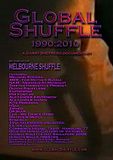Few musics manage to be all of these things in their lifetime. Dangdut, Indonesia's big native pop genre is probably exceptional in being all of them. At the same time. Welcome to the story of what might be the most multiple personality-stricken genre in the world today.
 Dangdut has some roots ranging back to Malay folk music from the forties, but it was in the early seventies that things really started to happen. Influenced by Indian film music, and by some accounts Arabic pop music, young, poor Muslims (ie. the indonesian majority, not devout Muslims per se) started experimenting with a synthesised pop form that contained local flavours, western-oriented electric guitars and a large dollop of tablas. The tablas are what gives the genre its name - "dang-dut" was a derisive description of their sound in a sanctioned government newspaper. As usual the elites disdained any new expression of working-class creativity.
Dangdut has some roots ranging back to Malay folk music from the forties, but it was in the early seventies that things really started to happen. Influenced by Indian film music, and by some accounts Arabic pop music, young, poor Muslims (ie. the indonesian majority, not devout Muslims per se) started experimenting with a synthesised pop form that contained local flavours, western-oriented electric guitars and a large dollop of tablas. The tablas are what gives the genre its name - "dang-dut" was a derisive description of their sound in a sanctioned government newspaper. As usual the elites disdained any new expression of working-class creativity.And in the seventies in Indonesia those elites were pretty much General Suharto. His 31-year dictatorship wouldn't have been possible without a bit of common sense and he let most singers (like The Queen of Dangdut Elvy Sukaesih) go on performing. More troubling was the genres superstar (and King) Rhoma Irama, whose anti-establishment Islamic message and rock-infused music made him enormous and surprisingly powerful. Suharto didn't dare touch him, but made sure he stayed off television, and eventually managed (in a typical Suharto move) to neutralise him by bringing him in as a supporter of the regime.
Irama was probably the first to play around with the mixture Indian film music - pop - Malay folk, but he certainly wouldn't be the last. During the seventies disco and synth appeared as Dangdut components, followed by a veritable explosion of house, hard rock and what-have-you dangdut variants. The music is incredibly open to variety in influence, and whereas most genres tend to settle down fairly quickly dangdut is just as varied as it was 30 years ago and doesn't seem to stop evolving. Even compilations of the genre will veer wildly from totally traditional to completely remixed (with only the basic structure in common) and club nights usually feature all sorts of mixed music.
It's not strange then perhaps that it's so many things to so many people. By the late nineties this once-controversial genre had settled into broad mainstream popularity, but then how do you explain something like this?
Dangdut has easily the filthiest dancing of any music I know of, mapouka included. Just look at it.
It's fascinating and a huge step in a strange direction from when dangdut last made international headlines, when recent superstar Inul Daratista was banned by religious authorities (and criticised by Rhoma Irama) for her supposedly lascivious dancing. But her dance moves are elegant and balletic compared to this stuff. Are we seeing another mapouka development where dangdut is turning into porn? Probably not, because debates like this one seem to indicate the dirty sort of dancing is far from being disliked by young people in general.
It seems like an unusual direction for a genre that is so strongly Muslim in its image, but maybe it just goes to show just how open-ended the music is. It co-exists on so many levels, safe and dangerous, political and apologist, traditional and modern, and it'll be fascinating to see where it goes to next.
(edit: There are some futher developments here and here that I didn't spot at first. The "sexy dangdut" seems to be developing a whole subcategory of its own, it's very interesting stuff.)










































No comments:
Post a Comment